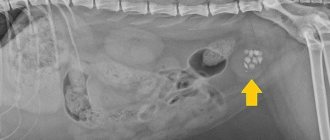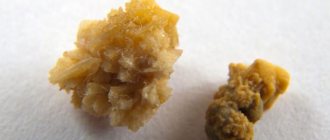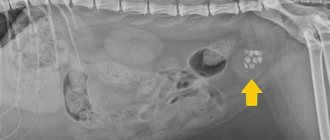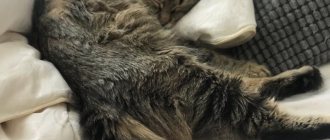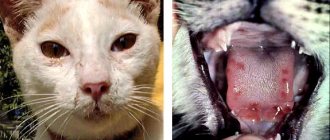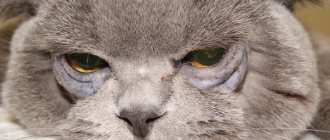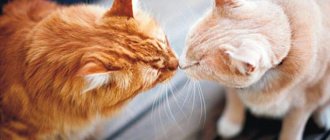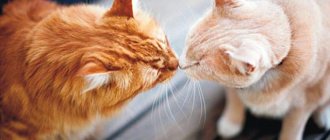Urolithiasis (UCD) or “urolithiasis” is a disease that, according to some data, occurs in 12% of cats. It manifests itself in the formation of stones - uroliths of different chemical nature - in the organs of the urinary system.
Depending on the chemical composition of uroliths (stones), ICD is divided into types:
- struvite,
- oxalate,
- urate,
- cystine or combined type of urolithiasis.
The most common types of disease in cats are struvite, oxalate, and a combined type of disease, in which both struvite and oxalate are found in one animal.
Stones can be found in the bladder, urethra, and less commonly in the ureters and kidneys. The clinical picture of urolithiasis can be observed when there are too many uroliths or they grow to a significant size and interfere with natural urination. In this case, a so-called “urethral plug” is formed, consisting of stones and an organic matrix. It is because of this that cats stop urinating and experience severe pain. Such an obstruction can be fatal to the animal and requires immediate action!
Males are especially susceptible to the disease and serious consequences. This is due to the anatomical structure of the cat's urethra, which is three times narrower than the cat's urethra, and also has an S-shaped bend in the area of the penis. All this can cause obstruction even with small stones.
How to distinguish cystitis from urolithiasis?
It is important to make a correct diagnosis in time, since the diseases have similar symptoms
: pain, frequent urge to urinate, blood in the urine.
The difference between these two diseases is in their nature. Cystitis is an inflammation of the bladder and most often is idiopathic (that is, essentially incomprehensible and unknown) in nature. The most common cause of idiopathic cystitis in cats is stress. Moreover, both hypothermia and the arrival of guests, rearrangement of furniture, change of filling and other things that a person often does not notice can act as a stress factor.
Cystitis in cats often recurs. In this case, you should pay attention to the cat’s habitat, try to eliminate stress factors or help the cat with medication. Various sedatives will help reduce stress: herbal drops, cat pheromones and antidepressants. If the former can be used at home, then you should consult your doctor about prescribing antidepressants. Sufficient water consumption is very important for this disease. Cats naturally drink little, but at home you can offer a variety of fountains with babbling water, bowls of different depths and diameters, as well as special dietary supplements that increase water consumption, for example, PURINA PRO PLAN GYDRA CARE.
Cystitis is a dangerous disease that does not forgive mistakes. Do not delay visiting a doctor if you suspect your pet has symptoms of cystitis. Medicines can prevent the severe consequences of the disease and certainly significantly improve your pet’s quality of life.
Urinary tract diseases
– a common problem in cats related to their anatomy and physiology. In this article we look at urolithiasis - a disease of the lower tract. In addition to urolithiasis and cystitis, there are other diseases of the urinary system, which a veterinarian can diagnose based on the results of an examination. A severe complication of urinary retention of any origin is acute renal failure. Even if the cat has not gone to the toilet for just a day, this can be very dangerous.
What causes struvite and oxalate type urolithiasis?
Struvite
in the bladder of cats, they usually form in young age, and oxalates - in middle age. In general, cats from 1 to 10 years old suffer from ICD. In kittens and older cats, the struvite type of urolithiasis occurs, caused by infection. In adult cats, oxalate urolithiasis is more common, and in adult cats, struvite stones are more common. Urinary tract obstruction is more common in cats.
The formation of struvite may be associated with inflammation or the presence of infection, as well as with an excess of magnesium, phosphorus, calcium, chlorine, and nitrogen compounds in the diet. Bacteria of the genus Staphylococcus and Proteus can cause struvite type of urolithiasis (especially in young cats).
Oxalates
are more often formed with a deficiency of potassium and sodium in the diet, as well as with overfeeding and obesity. Cats are predisposed to the oxalate type of urolithiasis, especially sterilized cats that live indoors and lead a sedentary lifestyle. Oxalates, unlike struvite, can be found in the kidneys. This disease is more common in older cats, 10-15 years old.
What influences the development of urolithiasis?
- Genetic, metabolic factors
- Violation of the drinking regime. Animals that do not consume enough fluids are at high risk.
- Heat. Exacerbation of urolithiasis can occur in hot weather, when urine becomes most concentrated.
- Creating a favorable environment for crystal growth - for example, increasing the concentration of urine if the animal has been patient for some time and has not gone to the toilet (for example, because the tray is dirty).
- Hormonal imbalance, including disruption of the thyroid gland due to a lack of iodine in the diet.
- The use of certain medications that promote stone formation (sulfonamides, calcium preparations, etc.)
As you can see, the reasons are very different, and not all can be influenced by animal owners. But some can still be taken under control: proper feeding of pets, avoidance of obesity and adherence to drinking regime
.
Before it’s too late, drink Borjomi!
There is no point in relying on medications that dissolve kidney stones. Today, despite the assurances of various commercials, there are no drugs that can dissolve formed oxalate and phosphate kidney stones (and these are the ones that occur in most patients). Only uric acid stones (urates) can be dissolved, and then only in some cases.
The mineral waters of our resorts can be recommended as a treatment only if the stone is small and can therefore easily be removed from the body. And what you definitely shouldn’t do is go to a resort against the opinion of a doctor who is offering you surgical removal of the stone. Moreover, today very gentle operations are possible.
What are the symptoms of urolithiasis in cats?
Symptoms of urolithiasis do not appear immediately. At the onset of the disease, small crystals in the bladder can only be detected by chance during a routine examination (ultrasound or urinalysis). Then there are more crystals or they increase in size and begin to injure the walls of the bladder or urethra. The cat experiences pain and problems urinating.
What should immediately alert the owner?
- The pet often goes to the toilet, and urine is released in small portions or not at all.
- Urine becomes more concentrated, may acquire a pungent odor, and contains blood.
- Each urge to urinate is accompanied by pain and meowing.
- The cat begins to go to the toilet in the wrong places, urinate on the bed or in the middle of the room, even if such behavior was not noticed before. The reason for this is pain.
- The pet becomes lethargic, indifferent, stops eating or eats very little, even from its favorite food.
- If urination does not occur, the bladder increases in size, the pet's belly becomes round, tight and painful. This condition is very dangerous, since at this moment the amount of harmful metabolic products in the blood, which are normally excreted in the urine, increases. The electrolyte balance is disturbed. This complication is called acute renal failure, in which the pet falls into lethargy, body temperature and blood pressure drop, and the animal is on the verge of death. Of course, it is better not to bring the cat to this state, and home help in such a situation is already useless. The animal must be urgently taken to the clinic.
How to provide first aid to a cat with urolithiasis?
1. Relieve pain
First of all, the animal needs to be given pain relief. Many drugs used for pain relief in human medicine are toxic to cats. For example, tablets containing paracetamol or ibuprofen. From the home medicine cabinet, a good remedy may be no-spa, papaverine or banal analgin. A medium-sized cat can be given 1/4-1/5 tablets.
Herbal preparations such as cystone, canephron, urolesan or its analogues, stop cystitis for cats can also be useful in the initial stages of the development of the disease.
2. Monitor your pet's bladder emptying
If there are several cats in the house, this task can be difficult. If your pet does not urinate for several hours, but still goes to the litter box and experiences endless urges, contact your veterinarian.
3. Show the animal to the doctor
To make a diagnosis, the doctor will analyze the medical history (information from the owner) and examine the animal. Sometimes ultrasound and urine analysis are sufficient for diagnosis. Blood tests are needed to assess the extent of kidney dysfunction.
Life story...
As an introduction, here is a real incident that happened several years ago...
The ambulance was flying through the city at night, cutting through the darkness with its headlights. An ordinary challenge that doesn’t stand out in any way from a series of hundreds of others. Male, forty-two years old, acute pain in the lumbar region. The doctor looked at the call sheet, weighing a possible diagnosis in his head. The car ran its headlights along the wall of the house, turning into the yard. In the faint light of the lantern one could see a well-groomed courtyard with a children's swing and a flowerbed. The ambulance stopped at the right entrance. Grabbing his suitcase, the doctor hurriedly ran up the steps and dialed the number on the intercom. The elevator took him to the sixth floor, where a pretty, fragile woman was already waiting for him, chillyly wrapped in a coat thrown over her shoulders.
The doctor entered the apartment, hastily washed his hands and, wiping them with a towel as he went, walked into the room. The man was lying on the sofa, the rumpled sheets indicating that he had apparently recently had a seizure. Now, apparently, the pain had subsided and he, gradually coming to his senses, squinted, trying to see the doctor’s face. The doctor said hello, sat down on the edge of the sofa and, asking the usual questions about complaints, threw back the blanket. The patient's entire abdomen, thighs and back were covered with small bruises. The doctor looked at the man in confusion:
- Who are you? “Wife,” answered the patient. - Is she hitting you? – the doctor asked in complete confusion, glancing sideways at the pretty woman standing next to him. - It stings. - Does it sting? For what?? The patient sighed and weakly waved his hand. “Doctor, he has a kidney stone,” the woman explained. “We were told that if you pinch it, it can come out on its own...
What could be the treatment?
Treatment of urolithiasis can be conservative or surgical. Since we often cannot influence the true cause of the development of KSD, this disease is prone to relapse. The attack may occur without blockage of the urinary tract or with complete obstruction. The first thing to do if the outflow of urine is disrupted is to evacuate it from the bladder. This is done using a catheter or, if it is impossible to install a catheter, by puncturing the bladder. The urethral catheter is sometimes left in place for several days and the owner is given clear instructions for care.
In severe cases, such a patient requires hospitalization, since without full fluid therapy it is impossible to correct renal and electrolyte parameters. However, more often, after prescriptions from a doctor, the cat is sent home with the owner for outpatient treatment.
The treatment regimen for urolithiasis includes
- painkillers in tablets, drops or injections,
- means for relaxing the muscles of the bladder and urethra,
- sedatives
- special diet.
As a relaxant of the smooth muscles of the urinary tract
, you can use cornam (terazosin). But in cats at high risk of urethral obstruction, this drug is prescribed with caution.
Diuretics
, as a rule, are not used. This is because with this disease there are no problems with urine formation and there is no need for stimulation. On the contrary, diuretics can worsen the pet’s condition by accelerating the process of dehydration and intoxication.
Antibiotics
They are not used primarily in treatment, since this disease is rarely complicated by a bacterial infection. The basis for antibiotic therapy is usually the results of urine culture. In the laboratory, analyzing the sample, they isolate bacteria that complicate the course of the disease and select antibacterial drugs to which these bacteria are sensitive. This could be sinulox, furagin, furadonin or other medications in tablets or injections. Dexamethasone and similar hormonal drugs are not used in the treatment of urolithiasis in cats.
When prescribing treatment, it is important to know which type of salt caused the urolithiasis. Struvite crystals respond well to lysis (resorption) with the help of a special diet. With the oxalate type of urolithiasis it is more difficult; it is important to prevent the growth of crystals and ensure normal urination.
Recommendations for choosing food
A special diet for pets with urolethiasis requires the mandatory consumption of therapeutic and preventive food for at least 1 month. The attending physician draws up a detailed nutrition plan and gives recommendations on feeding during and after rehabilitation.
The choice of food for urolithiasis in cats depends on the type of stones formed:
- in the presence of oxalates, it is necessary to reduce the amount of oxalic acid and calcium in the diet. In this situation, Hill's Prescription Diet Feline X/D and Eukanuba Oxalate Urinary Formula mixtures are suitable;
- If phosphate stones are detected, the calcium content in food should be limited. Experts recommend paying attention to the specialized diet Hill's Prescription Diet Feline S/D, Hill's Prescription Diet C/D, Eukanuba Struvite Urinary Formula, Royal Canin Urinary S/O, Purina UR.
Many manufacturers have medicinal products in their product line that are designed specifically for animals with pathologies of the urinary system. A veterinarian will help you choose a suitable diet and calculate its daily intake. It should be remembered that industrially produced products cannot be combined with homemade food, much less mix them in one bowl. When choosing a balanced diet, you should give preference to high-quality balanced feed.
What to do if treatment does not bring results?
If conservative treatment is ineffective in cats with recurrent urethral blockage, surgery is performed - urethrostomy. The essence of the operation is that the cat's urethra is made straight and wide, like a cat's. As a result, sand and small stones no longer get stuck in the narrow S-shaped section of the male’s urinary tract, but are washed out with a stream of urine.
Caring for a cat after surgery involves treating the stitches and preventing them from licking. A cat's rough tongue can prevent sutures from healing and inflammation from the delicate skin at the site where they are applied. Therefore, the cat must wear a special protective collar throughout the healing period, and the stitches must be treated with water-based antiseptic solutions as recommended by a doctor.
Diagnostics
Only a specialist can determine the presence of urolithiasis. Diagnostic methods:
- inspection;
- ultrasonography;
- Analysis of urine;
- x-rays.
Urolithiasis in cats is determined by the amount of proteins, examination of urine sediment, and pH level.
Two methods are used to collect liquid for analysis. In the first case, they empty the tray with the mesh; in the second, they buy special granules designed to collect urine. They look like regular filler and are sold complete with a test tube.
What does modern veterinary medicine and Purina offer to solve the problem?
Veterinary medicine is a rapidly developing science. In the modern world, the standards for treating diseases have changed greatly, compared to even 5 years ago. Previously, in the absence of knowledge and capabilities in the field of diagnosis and treatment of urolithiasis, they tried to fight this serious disease with the help of folk remedies or drugs that are not only useless, but can also harm the animal or delay real treatment and lead to serious consequences.
A big discovery in recent years has been dietary diets that can correct the condition of cats with urolithiasis or prevent the disease and its relapses. For example, PRO PLAN® VETERINARY DIETS UR ST/OX URINARY FOR CATS WITH DISEASES OF THE LOWER URINARY TRACT allows you to dissolve struvite stones and prevent the growth and formation of oxalates.
These foods promote the production of undersaturated, not very concentrated urine and therefore prevent the formation of crystals. Moderate fat and calorie content allows you to maintain normal body weight. The food is recommended for the treatment of urolithiasis and prevention of relapses and can be used for a long time. Knowing the capricious nature of cats, diet companies produce products with different tastes. The food can be based on meat, fish or chicken protein. With a homemade diet, it is almost impossible to balance a complete diet for a cat with urolithiasis. There are no products that would help dissolve stones and be complete and usable for cats. Meat contains too much magnesium, phosphorus and protein, milk has a high calcium content. But the mineral composition of the diet is especially important for cats with diseases of the lower urinary tract!
We have already said that urolithiasis in cats has many causes. The owner’s task is to eliminate those causes that he can influence. A nutritious diet containing vitamins and minerals in the right quantities is the key to your pet’s health. For indoor cats that have been spayed or neutered, it is also important to maintain an ideal body weight. Obesity increases the risk of many diseases, including cystitis and urolithiasis.
Proper drinking regime is also extremely important.
pet. Cats, by their nature, are animals accustomed to retaining fluid in the body in conditions of its deficiency. Therefore, a domestic cat fed wet food or a diet from the owner's table may drink very little or not drink at all. However, milk or cream is not considered a complete drink. If your cat is fed a commercial dry diet, she definitely needs to drink water. Therefore, be sure to always ensure that there is clean water in your animal’s bowl - cats are very sensitive to the freshness of water. The cat will not drink liquid contaminated with food or, for example, dog saliva. Therefore, the water bowl should be kept away from the food bowl.
Many cats prefer the babbling stream of tap water. Such animals will enjoy various fountains that stimulate thirst. Developed by Purina, PURINA® PRO PLAN® Hydra Care is served in a separate bowl to complement the main diet and helps increase your cat's overall fluid intake.
And if your pet has already had an attack of urolithiasis, specially developed test systems - cat litter with ICD indication - will help you not to miss a relapse and react in time. This test filler contains substances that allow it to change color depending on the pH (acidity of urine). The color of the filler must be compared with the scale, and as a result you will understand whether there is a risk of recurrence of cystitis or urolithiasis right now.
Prevention and more prevention
As already mentioned, the main cause of the development of the disease is an inborn error of metabolism. Therefore, if many of your relatives suffer from this disease, you better be attentive to yourself and adhere to the following recommendations:
- Do not consume : broths, chocolate, coffee, cocoa, spicy and fried foods.
- Limit : the total amount of food (do not overeat), consumption of fatty foods, table salt.
- Drink a lot of water, at least 1.5 liters. per day. In summer you should drink enough to never feel thirsty.
- Regularly take diuretic infusions or decoctions of various herbs.
- Do not get too cold, always keep your lower back warm.
- If you experience even slight discomfort in the lumbar region, immediately contact a urologist.
As for the “pinched” patient, whom we talked about at the very beginning, he, of course, got help. The stone was crushed, and so carefully that only the slowly disappearing bruises from the extravagant method of self-medication that he had invented reminded him of his recent illness.
Is it possible to cure urolithiasis in cats?
As a rule, this disease cannot be cured, but surgery can achieve stable remission and eliminate relapses in most cases. Small crystals may form, but they will no longer cause pain and discomfort for the pet, but will be washed away daily by a stream of urine. With the right food/diet, some of the stones can be dissolved and they do not form again. Adequate fluid intake helps prevent urine concentration and inflammation in the bladder. Therefore, cats with ICD can live as long as animals that are luckier, but require more attention from their owners.

